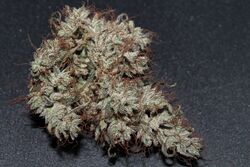Rooibaarb: Difference between revisions
More actions
Oldworldnugs (talk | contribs) |
Eloise Zomia (talk | contribs) No edit summary |
||
| Line 1: | Line 1: | ||
{{LandraceEntry | {{LandraceEntry | ||
| name=Swaziland | | name=Swaziland Rooibaard | ||
| region=Eswatini (Swaziland) | | region=Eswatini (Swaziland) | ||
| status=Vulnerable | | status=Vulnerable | ||
| Line 8: | Line 8: | ||
| seedbank_tier=Tier 2 | | seedbank_tier=Tier 2 | ||
| image=Swaziland_Rooibaarb.jpg | | image=Swaziland_Rooibaarb.jpg | ||
| genetics=Tall, equatorial NLD landrace noted for its reddish stems ( | | genetics=Tall, equatorial NLD landrace noted for its reddish stems (“rooibaard”) and soaring psychoactive effects. | ||
| notes=Traditional use includes both ritual smoking and barter in rural markets. Increasingly threatened by modern hybrids. | | notes=Traditional use includes both ritual smoking and barter in rural markets. Increasingly threatened by modern hybrids. | ||
}} | }} | ||
| Line 15: | Line 15: | ||
=== Overview === | === Overview === | ||
Swaziland | Swaziland Rooibaard is a traditional landrace cannabis from the highlands of Eswatini, recognized for its striking reddish stalks and stems. Known locally for its long flowering cycles and highly psychoactive effects, it holds cultural importance among smallholder farmers and traditional users. | ||
=== Geography & Habitat === | === Geography & Habitat === | ||
Latest revision as of 08:17, 27 August 2025

Overview
Swaziland Rooibaard is a traditional landrace cannabis from the highlands of Eswatini, recognized for its striking reddish stalks and stems. Known locally for its long flowering cycles and highly psychoactive effects, it holds cultural importance among smallholder farmers and traditional users.
Geography & Habitat
This landrace is native to Eswatini’s mountainous and subtropical regions, where it grows in sandy, mineral-rich soils under long photoperiods. Plants reach extreme heights (3–4 meters) when cultivated outdoors, making them suited to open-air highland agriculture.
Conservation Status
Classified as *Vulnerable* due to rapid hybrid infiltration from imported commercial strains, which are replacing traditional landraces in cultivation. Conservation seedbanks hold limited accessions, with Zomia Collective currently preserving Tier 2 material.
Characteristics
Morphology: Tall, slim NLD structure; reddish stalks (“rooibaarb” trait); narrow leaflets; airy colas.
lowering: Very late-flowering, 14–16 weeks.
Aroma/Flavor: Sharp, acrid spice with earthy undertones.
Effects: Potent, clear, and long-lasting cerebral high, sometimes overwhelming to unacclimated users.
Accession Details
Accession ID: ZOM-2019-SZ-004
Collector: Zomia Collective
Collection Date: 2019-03-21
Seedbank Tier: Tier 2 (stable preservation)
Cultivation & Traditional Use
Locally cultivated by subsistence farmers for barter and ritual consumption. Plants are typically grown on hillsides and harvested late into the dry season. Cured flowers are smoked in communal settings and sometimes traded across borders into South Africa.
Genetics & Research Notes
Believed to be a pure equatorial NLD (Narrow Leaf Drug type). Distinct for its reddish stem pigmentation, likely related to anthocyanin expression. No known hybrid admixture in conserved accessions, though wild populations are under threat.
Threats & Conservation Efforts
Hybridization: Increasing cultivation of commercial high-yield hybrids.
Economic pressure: Farmers shifting to more profitable or fast-yielding strains.
Conservation: Zomia Collective and independent seed savers are maintaining ex-situ accessions.
References
- Zomia Collective field notes, 2019.
- Clarke & Merlin (2016). *Cannabis: Evolution and Ethnobotany*.
External Links
- [Landrace Wiki – Eswatini Entries](https://landrace.wiki)
- [Zomia Collective](https://zomiacollective.org)